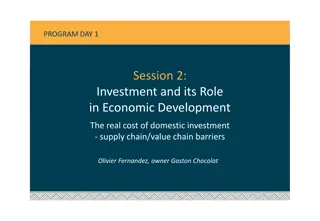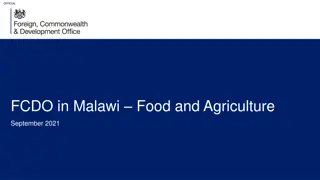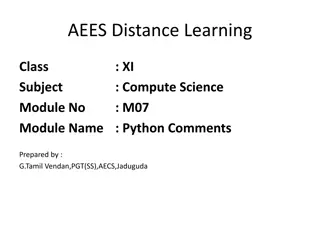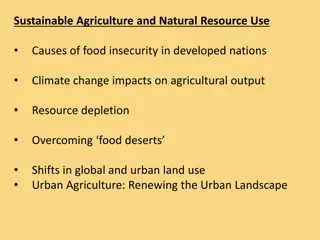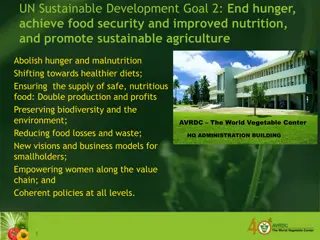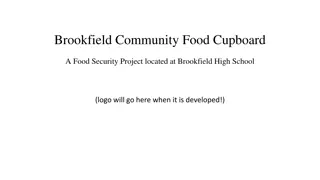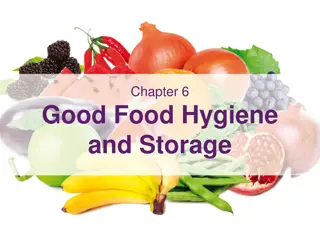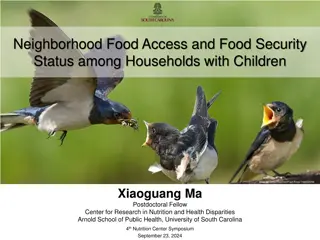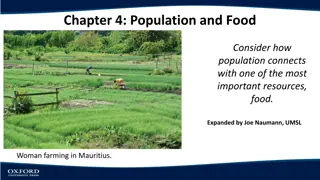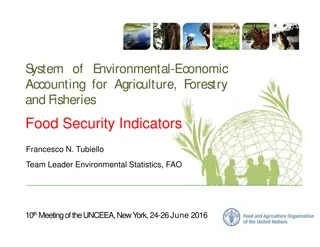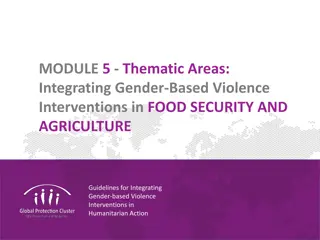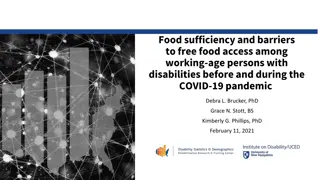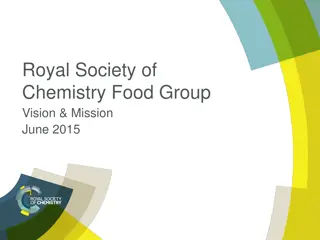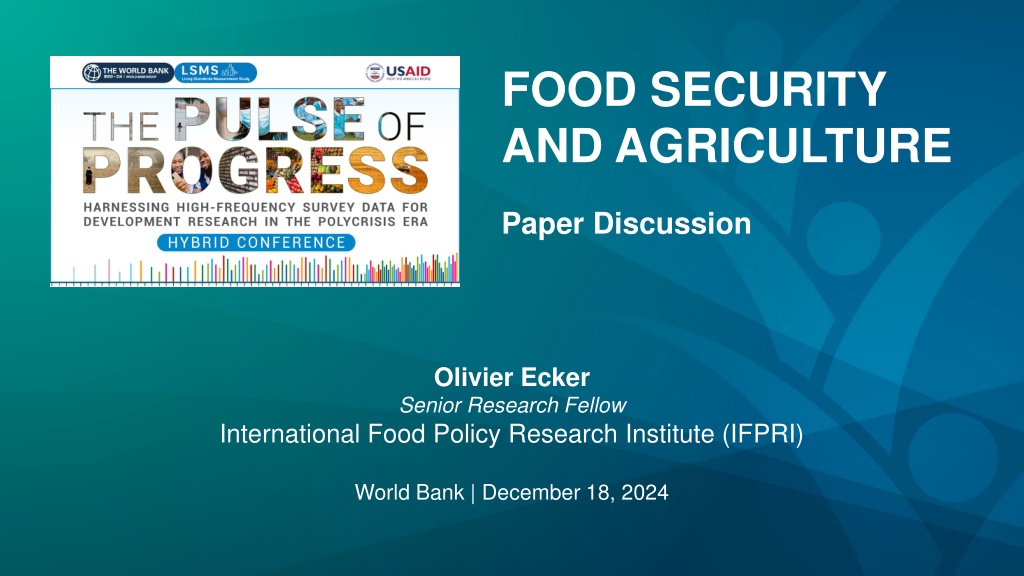
Food Security and Agriculture Research Insights
Gain valuable insights into food security and agriculture research through a collection of papers addressing migration, agricultural commercialization, and subjective well-being, utilizing high-frequency survey data. Explore the impacts of food insecurity on migration intentions, assess the role of agricultural commercialization during crises, and delve into the relationship between food security and subjective well-being in various regions. Discover the challenges and opportunities in utilizing perception-based measurements of food insecurity for in-depth analysis and policy formulation.
Download Presentation

Please find below an Image/Link to download the presentation.
The content on the website is provided AS IS for your information and personal use only. It may not be sold, licensed, or shared on other websites without obtaining consent from the author. If you encounter any issues during the download, it is possible that the publisher has removed the file from their server.
You are allowed to download the files provided on this website for personal or commercial use, subject to the condition that they are used lawfully. All files are the property of their respective owners.
The content on the website is provided AS IS for your information and personal use only. It may not be sold, licensed, or shared on other websites without obtaining consent from the author.
E N D
Presentation Transcript
FOOD SECURITY AND AGRICULTURE Paper Discussion Olivier Ecker Senior Research Fellow International Food Policy Research Institute (IFPRI) World Bank | December 18, 2024
Papers 1) Jorge Soler-Lopez: The Push from Hunger: Migration Amidst Persistent Food Insecurity in Latin America. 2) Tulia Gattone & Cosimo Magazzino: Agricultural Commercialization and Food Security during COVID-19: A Machine Learning Application on High-Frequency Phone Surveys in Sub-Saharan Africa. 3) Martin Chegere: Exploring the Link Between Food Security and Subjective Well- Being using Tanzania High Frequency Phone Survey. 4) Anna Josephson: Food Security among Subsistence Farmers: Challenges of Understanding and Assessing Changes using High-Frequency Phone Survey Data.
The four papers Demonstrate the importance of high-frequency survey data for addressing various food- security-related, policy-relevant research questions (e.g., migration, ag. commercialization, subjective well-being) and measurement issues (e.g., precision vs. accuracy), for which evidence is most urgently needed during crises. Highlight the uniqueness and usefulness of the HFPS data for longitudinal analysis on short- / medium-term impacts of shocks esp. in multi-country studies. Are faced with the data limitations of the HFPS, but differ in defining the scope of the analysis and dealing with the data constraints. Use the FIES index (or components) as dep. var. or main indep. var. a perception-based measurement of food insecurity (FI). Is it a valid food security indicator for use in HH-level (panel data) analysis?
Soler-Lopez: Migration & FI in LAC Objective: FI as a push factor of the intention to migrate. What about pull factors and enablers (beyond remittances)? Data: 5-country, pooled HH sample (cross-sectional). Focus on CA countries (no DOM) for greater sample homogeneity, etc.. Construct a HH panel dataset? Methods: LPM, with HH controls and country-FE. More can be done. Indep. var. constructed from only subset of FIES questions. Why? Use data also from earlier survey waves? Results: Migration intention FI relationship. Focus on drivers (rather than determinants) and expand on model specifications: Explore all changes (+|-) and in both vars, for all FI levels. Discussion: o Differential effects by wealth and educational levels. Good, but why only as descriptive results? o Human capital loss and realization of migration. Detached from the analysis. Several statements don t relate to the estimation results (and are unreferenced).
Gattone: Ag. commercialization & FI in SSA Objective: Ag. commercialization as a coping strategy for FI during crisis. Or, is it rather a usual process of ag. transformation? Data: 5-country, pooled HH sample, 2020-2023. Suitable to address the research question; incl. mismatch between shock observation period and ag. seasons in 2019-20? Contribution: Evidence on the potential of ag. commercialization for FI. Knowledge gap / innovation? Methods: Various regression models (OLS, DiD, Panel FE, SEM, Ridge, Lasso) and ML techniques (XGBoost, ANN). Inconsistency in model assumptions and differences in coef. interpretation. Added value of each model included? Indep. var.: Main crop marketed (binary). Inadequate indicator of ag. commercialization. Conclusions: Policy implications on promotion of commercialization among smallholders, rural infrastructure investments, and inclusivity of ag. commercialization through targeted support. Beyond the results of the analysis.
Chegere: Subjective well-being & FI in TZA Objective: Relationship between FI and subjective well-being (SWB). Food security is a main factor of HH well-being. Research question? Data: Balanced HH panel. Good, but high attrition (43% across 4 waves). Methods: CRE (and FE) model. Add model specifications to study pathways (and deal with endogeneity); drop single FIES component and food price regressions (providing little insight). Results: Negative marginal FI effects on overall SWB, but positive effects on food- and health- related well-being (Tables 2-4). Correct estimates? Interpretation? General comments: o Dep. and indep. vars are perception-based. Limitation or opportunity for more in-depth analysis? o Temporal variation and alternation of SWB assessment between HH subsamples. Can be exploited, esp. when coincide with an external shock.
Josephson: Challenges & opportunities of HFPS Objective: Trade-offs between precision and accuracy in FI measurement. What is the gold standard of the assessment? Contribution: A critical review of FI measurement methods and metrics. Knowledge gap? Claim: More and more frequent data is better! Not necessarily, considering survey fatigue, opportunity costs, etc.


